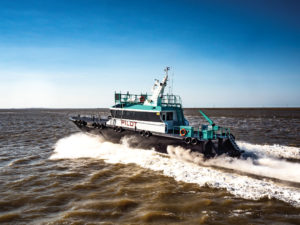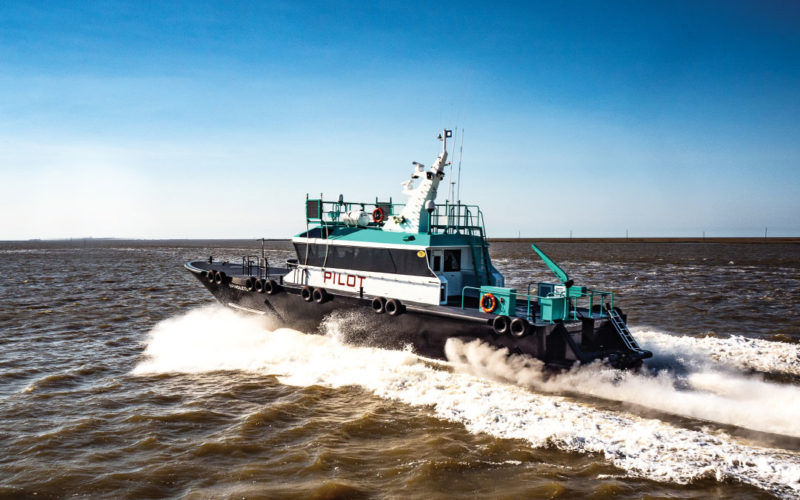
One of the largest high-speed aluminum pilot boats in North America is now operating in Sabine Pass.
The 90-by-23-foot Spindletop was delivered to the Sabine Pilots of Port Arthur, Texas, in March 2021. Breaux’s Bay Craft of Loreauville, La., built the vessel using an in-house design. It is named for an oil field discovered in 1901 near Beaumont, Texas, that ignited the state’s petroleum industry.
The Sabine Pilots developed and outfitted Spindletop to expand their capabilities within the Sabine-Neches Waterway (SNWW). Specifically, it can carry up to 14 pilots and quickly cover ground between the port and waiting ships up to 28 miles out to sea.
Spindletop’s arrival coincides with rising port calls by liquefied natural gas (LNG) carriers and oil tankers in the Texas cities of Beaumont, Port Arthur, Orange, Port Neches and Nederland. During the buildup to the pandemic, port calls — and thus pilot boat utilization — increased by a third, said Capt. Charles Tweedel, president of the Sabine Pilots.
“With the effects of (Covid-19), LNG ships dropped from 30 to six or eight per month, along with a drastic decline in crude oil movements,” he said. “The pilots returned to two boats on station. But it’s slowly coming back up to pre-Covid levels.”
The U.S. found itself awash in natural gas following the expansion of horizontal drilling and hydraulic fracturing. Natural gas prices fell sharply, rendering nearby LNG import and regasification terminals underutilized or even idle.
In 2012, the Federal Energy Regulatory Commission authorized the existing Cheniere Energy regasification terminal at Sabine Pass to be converted to an LNG liquefaction export terminal. Cheniere Energy is now the largest exporter of LNG in the U.S. and one of the top LNG operators globally.
Another local operation, Golden Pass LNG, is currently converting its import infrastructure to allow for exports. Sempra LNG is developing an export site, the Port Arthur LNG project, upriver from Golden Pass. Together, the three terminals constitute the largest LNG capacity in North America. The Sabine Pilots service all three.
On the crude oil side, the SNWW is home to the Motiva Enterprises Port Arthur Refinery. It is the largest crude oil refinery in North America and the largest base oil plant in the U.S. That ranking will soon be usurped by Exxon Mobil, when the expansion of its Beaumont refinery is complete in 2023.
“The waterway is also home to the Army’s 842nd Transportation Battalion and is the No. 1 Military Outload (MOL) waterway in the U.S.,” Tweedel said.
On a bright spring day, with four ships anchored at the sea buoy some 20 miles offshore, Sabine Pilots port captain Leslie Tucker guided Spindletop through Sabine Pass and ultimately into a 3-foot sea in the Gulf of Mexico. Spindletop, swift for its size, has a deep-V hull that knifed through the chop with ease and comfort. The hull was fitted with Humphree interceptors that improve stability and motion control.
The pilots aboard were ensconced in four of 15 Norsap gas-sprung chairs in the pilothouse. Boat operator Dylan Simmons sat in the one located on the port side of the forward control console. Tucker, seated in a Norsap captain’s chair equipped with a boatload of features, brought the vessel up to 27 knots.
“Really, there’s nothing I don’t like about this boat,” said Tucker, who joined the Sabine Pilots on deck 32 years ago. “I especially like the fuel efficiency, the electronics, the FLIR camera and the creature comforts.”
Simmons echoed the sentiment. “The other day, we made 20 knots in a 9-foot sea, and the ride was very comfortable,” he said. The HamiltonJet waterjets, he added, make for exceptional maneuverability.
Spindletop is awash in state-of the-art equipment, safety features and crew comforts. The wheelhouse electronics could double as a mobile Furuno showroom display, with two Furuno radar scanners and multifunction displays, AIS, sonar and weather station. The communications suite includes Icom VHF radios with command microphones, a KVH TracVision TV3 motion satellite system, DirecTV and SiriusXM system with satellite radio.
The safety equipment aboard reflects the priority of, and attention to, pilot and operator safety. That includes LED lighting throughout the boat, improving safety during nighttime operations. Spindletop has a Harken Tight Radius rail system for pilots and crew to hook into while moving around the pilothouse when underway.
The wheelhouse has a stand-alone 10-inch monitor displaying images from six cameras aimed at the boarding area, aft deck, machinery space and jet room. The boarding platforms, fitted with rails, are located forward of the pilothouse, port and starboard, and port and starboard atop the cabin.
The roof is fitted with a FLIR M400XR stabilized thermal/visible camera, with four FLIR thermal and visible imaging cameras for temperature measurement. The transom is equipped with a custom SeaLift rescue platform and a jib pole. Rounding out the safety kit are a Revere Coastal Commander life raft, a USCG-approved flare kit, a battle lantern, throw rings and lifejackets for 16 people.
Another nod to safety is the HamiltonJet JETanchor positioning system. “The JETanchor utilizes a virtual anchor 15 meters in front of the boat, allowing the boat to settle into the seas, winds or current, whichever is greatest,” said Kenneth Hurd, boat superintendent. The anchor improves fuel efficiency and lessens crew fatigue by reducing trips back and forth to the dock between ships.
The propulsion chain consists of four 800-hp Scania diesel engines paired with Twin Disc reduction gears, all shafted to the HamiltonJet drives. The propulsion package gives the boat a running speed of 27 knots and a top speed approaching 31 knots.
“When designing the Spindletop, we needed a bigger boat to access a new buoy 11 miles farther south than our current one that is 17 miles out,” said Hurd. The lighter Scania engines reduce fuel consumption during long runs back and forth to the dock.
Like many Gulf Coast yards tied to the oil industry, newbuilds in the oil field support boat market collapsed along with falling oil prices. The history of diversity at Breaux’s Bay Craft came into play to fill the loss of crew boat orders. The yard, nestled along Bayou Teche, increased its concentration on pilot boats and developed the deep-V hull design. The yard delivered its first new-generation deep-V boat, a 54-footer, to the Tampa Bay Pilots Association in November 2019.
That deep-V bottom design utilized by the Sabine Pilots has earned its share of praise. “This new Breaux hull has been outperforming our current fleet with speed, fuel consumption and in bad-weather handling,” Hurd said. •

